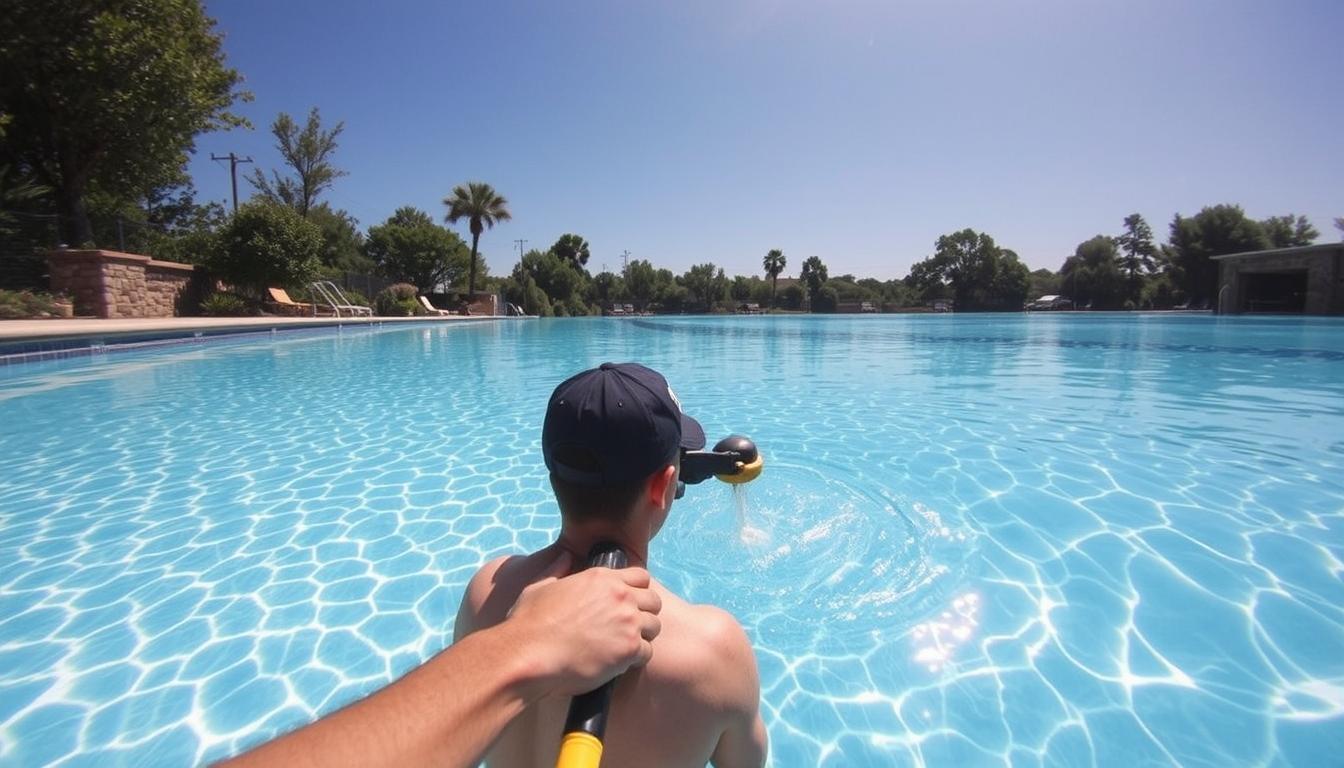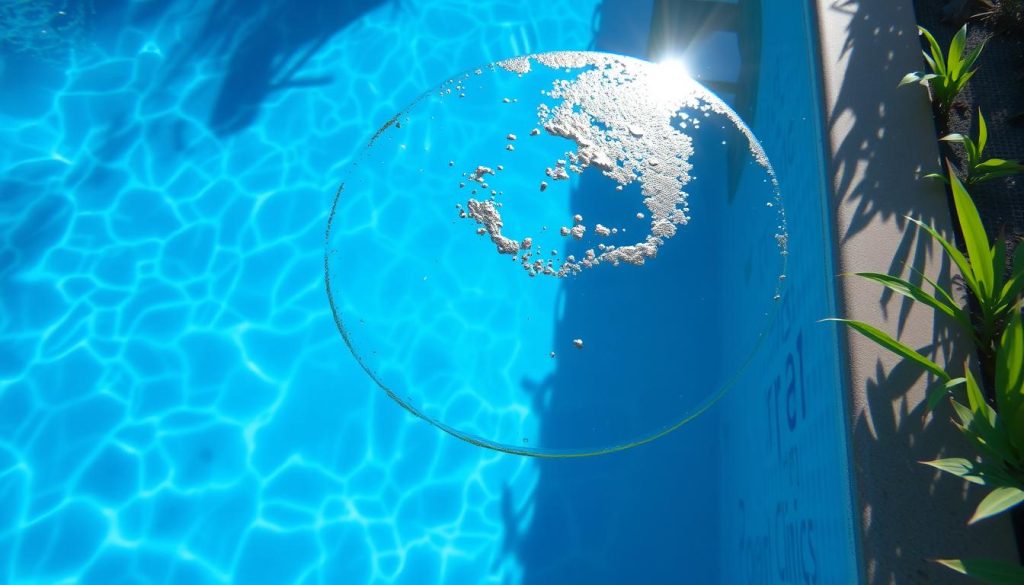
Ever dreamed of diving into crystal clear pool water? Sometimes, an unsightly film forms on the surface. This floating surface layer or liquid skin is a common pool issue with various causes.
A film on top of pool water can be frustrating. It creates an unpleasant water surface effect that disrupts the water surface tension. This pool water membrane looks unappealing and can affect water chemistry and circulation.
Don’t worry! You can remove this film and restore your pool’s sparkle. We’ll explore pool surface film types and removal methods. You’ll learn how to maintain a clean, inviting pool water surface for everyone to enjoy.
Key Takeaways
- Pool surface film is a common issue that can be caused by white water mould, lotions, sunscreens, pollen, and organic debris.
- Surface film disrupts water surface tension and creates an unsightly appearance on the pool water surface.
- Identifying the type of pool surface film is crucial for effective removal.
- Maintaining proper water chemistry, using pool flocculants, and employing skimming and brushing techniques are key methods for removing pool surface film.
- Regular pool maintenance and cleaning routines can prevent the formation of pool surface film and keep your water sparkling clean.
Understanding Pool Surface Film
Pool owners aim for clean, clear water. Sometimes, a thin film appears on the surface. This film can be unsightly and may signal water chemistry issues.
Surface film can indicate problems with circulation. It’s important to address these issues for a better swimming experience.

What Causes Film on Top of Pool Water?
Several factors can create a film on pool water. Poor water circulation and imbalanced chemicals are common culprits.
Organic contaminants like leaves and pollen can also contribute. High swimmer traffic introduces oils and lotions that may form a film.
- Poor water circulation: When water is not circulating properly, it can lead to stagnant areas where organic contaminants accumulate and form a film.
- Imbalanced pool chemicals: If the pH, alkalinity, or sanitizer levels are not within the recommended range, it can cause a buildup of oils, lotions, and other substances on the water’s surface.
- Organic contaminants: Leaves, pollen, and other organic debris can introduce nutrients into the water, promoting the growth of bacteria and algae that contribute to surface film.
- High bather load: The oils, lotions, and sweat from swimmers can accumulate on the water’s surface, leading to the formation of a film.
Is Pool Surface Film Harmful?
Pool surface film may not directly harm swimmers. However, it can signal poor water quality and potential health risks.
The film can reduce sanitizer effectiveness and clog equipment. It also creates an unpleasant swimming experience.
- Reduced sanitizer effectiveness: A film on the water’s surface can prevent chlorine or other sanitizers from properly dispersing and disinfecting the water, allowing bacteria and other pathogens to thrive.
- Clogged filters and equipment: As the film accumulates, it can clog skimmers, filters, and other pool equipment, reducing their efficiency and potentially causing damage.
- Unpleasant swimming experience: A pool with a visible film or scum on the surface is unappealing and can deter swimmers from enjoying the water.
| Cause of Pool Surface Film | Effect on Water Quality |
|---|---|
| Poor water circulation | Allows organic contaminants to accumulate and form a film |
| Imbalanced pool chemicals | Leads to buildup of oils, lotions, and other substances on the surface |
| Organic contaminants | Introduces nutrients that promote bacterial and algal growth |
| High bather load | Contributes oils, lotions, and sweat that accumulate on the surface |
Knowing the causes of pool surface film helps prevent it. Maintain proper water chemistry and improve circulation.
Remove organic contaminants regularly. Next, we’ll explore types of surface film and effective removal methods.
Identifying Different Types of Pool Surface Film
Spotting pool surface films is key for keeping your pool clean. These films can be white water mould, oily residues, or organic debris. Let’s explore each type and how to tackle them.
White Water Mould
White water mould is a fungus that grows in pools with poor circulation. It looks like slime or torn-up tissue floating on the water. Indoor pools with little sunlight are more likely to develop this mould.
To fight white water mould, keep your pool’s chemistry balanced. Clean filters often to stop growth. Use a strong chlorine shock to kill the mould.
After shocking, clean filters multiple times. Watch the water for a few days to make sure the mould doesn’t come back.
Oily Film from Lotions and Sunscreen
Lotions and sunscreens can leave an oily sheen on the pool’s surface. This film looks bad and can make the water slippery. Ask swimmers to put on sunscreen 30 minutes before swimming.
Skim the pool surface often to remove oily film. Good filtration helps keep the water clear. Try using a pool flocculant to clump oily particles for easier filtering.
Pollen and Organic Debris
Pollen, insects, and leaves can create a film on your pool. This is common in spring and fall when pollen counts are high. Skim the surface regularly to control this debris.
According to the American Chemical Society, pollen particles can range from 15 to 200 microns in diameter, making them small enough to pass through some pool filters. This means that even with proper filtration, pollen can still accumulate on the pool surface.
Keep your pool’s chemistry balanced and run the filter 8-12 hours daily. This helps control pollen and debris. Using a pool cover when not swimming can reduce debris in the water.
| Type of Film | Characteristics | Prevention and Treatment |
|---|---|---|
| White Water Mould | Slime-like substance, torn-up tissue | Maintain proper water chemistry, shock pool, clean filters |
| Oily Film from Lotions and Sunscreen | Oily sheen on water surface | Apply products 30 minutes before swimming, shower before entering pool, skim surface, use flocculant or clarifier |
| Pollen and Organic Debris | Film or sheen on water surface | Regular skimming, balanced water chemistry, proper filtration, use pool cover when not in use |
Effective Methods for Removing Film on Top of Pool Water
Removing film from pool water is vital for a clean swimming environment. Proper water chemistry, flocculant use, and regular maintenance can eliminate harmful film. These methods ensure your pool stays inviting and safe.
Maintaining Proper Water Chemistry
Balanced water chemistry is key to a clean pool. Test and adjust chlorine, pH, and alkalinity levels regularly. Chlorine levels should be 1-3 ppm to prevent algae and bacteria growth.
Keep pH between 7.2-7.6 for effective chlorine and to prevent irritation. Maintain total alkalinity at 80-120 ppm to stabilize pH. This balance helps prevent sudden changes in water quality.
Using a Pool Flocculant
Pool flocculants clump small particles together, making them easier to filter out. Before using a flocculant, shock the pool with a fast-acting treatment. This eliminates organic contaminants that contribute to surface film.
When treating white water mould, a regular dose of chlorine shock may not be enough. Sometimes, a triple or quadruple dose may be necessary to effectively kill off the mould. The recommended shock dosage is 4 pounds of calcium hypochlorite per 10,000 gallons of water.
Skimming and Brushing Techniques
Physical maintenance is crucial for removing film on pool water. Skim the pool surface daily to remove floating debris. This prevents leaves, insects, and pollen from sinking and decaying.
Brush pool walls and floor regularly, especially after shocking and using flocculant. This dislodges remaining contaminants, allowing them to be filtered out easily. Thorough brushing ensures a cleaner pool surface.
| Method | Frequency | Benefits |
|---|---|---|
| Testing and balancing water chemistry | Weekly | Prevents contaminant growth and ensures chlorine effectiveness |
| Shocking with pool flocculant | As needed | Clumps together small particles, making them easier to filter out |
| Skimming pool surface | Daily | Removes floating debris before it can sink and decay |
| Brushing pool walls and floor | Weekly or after shocking | Dislodges remaining film-causing substances for easy filtration |
Conclusion
Preventing pool surface film requires a multi-faceted approach. Understanding the causes helps us take targeted steps to address each issue. Regular pool maintenance is crucial for a healthy and inviting swimming environment.
To fight white water mould, ensure adequate UV exposure for outdoor pools. Use a higher dose of chlorine shock treatment when needed. Clean the pool filter thoroughly and maintain proper water chemistry.
Test and balance pH, alkalinity, and chlorine levels regularly. Pool shock treatment helps eliminate bacteria and algae. Brush pool walls and floors to prevent scale buildup, stains, and etching.
Implement a consistent maintenance routine. This includes skimming the surface and brushing walls and floor. Run the filter efficiently and test water chemistry every few days.
Stay vigilant and address issues promptly for a sparkling, healthy pool. With the right knowledge and tools, maintaining clear pool water becomes manageable. This ensures a refreshing swimming experience for everyone.







